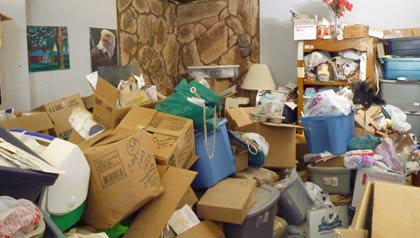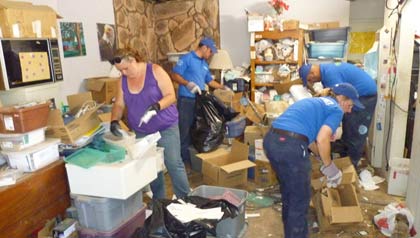Staying Fit


There is a loud rustling sound as the door to a two-bedroom apartment in an upscale Virginia high-rise slowly opens, catching on a knee-high mound of discarded plastic bags and junk mail. The sole occupant, a 68-year-old retired government consultant named John M., whose last name is omitted to protect his privacy, greets the first visitor he's allowed to see his home in months.
To the right is a small yellow kitchen, its stove buried under empty medicine containers, toilet paper rolls and used paper coffee cups that cascade onto the floor, forming a waist-high heap of trash. The sink doesn't work, but John won't call management, fearing his landlord's reaction to the mess. His spartan bedroom contains a single bed piled with old bank statements and ringed by more than a dozen paper shopping bags. Thick gray dust blankets most surfaces; it has accumulated in the four years since John moved in, abandoning his three-bedroom house where he still picks up his mail. That house is so stuffed with junk it has become uninhabitable.


AARP Membership— $12 for your first year when you sign up for Automatic Renewal
Get instant access to members-only products and hundreds of discounts, a free second membership, and a subscription to AARP the Magazine.
John is a hoarder, with a psychological illness that disproportionately affects older men and women.
Hoarders on TV, in books and on the Web
The disorder, poorly understood, is marked by a compulsive accumulation of usually worthless possessions — and a corresponding inability to discard anything — and has catapulted into the public consciousness in the past decade, spawning a burgeoning number of reality TV shows, self-help books, a recent best-selling novel and numerous websites. More than 60 municipal task forces have sprung up around the country to deal with a problem that distresses families, angers neighbors, stymies public officials and frustrates therapists.
"It's a problem that's coming out of the woodwork, especially with the older adult population," says social worker Susan Hoskins, executive director of the Princeton (N.J.) Senior Resource Center and its hoarding task force. "As a therapist I have found very few things that are as difficult to treat … and so hard for people to give up." Hoskins says she routinely fields beseeching calls from grown children of hoarders asking, "What am I going to do about this?"
A 2008 study by Johns Hopkins University scientists estimated that nearly 4 percent of the population are hoarders. Other researchers have found that many hoarders grew up with a parent who hoarded; scientists believe the disorder results from the interplay of genetic and environmental factors.


Chaotic collections
Unlike collectors, whose items tend to be neatly organized and who thin their collections periodically, hoarders closely resemble pack rats, says Randy O. Frost, a psychology professor at Smith College who pioneered the study of hoarding in the early 1990s. Frost, who has coauthored several books on the subject, the latest of which is Stuff: Compulsive Hoarding and the Meaning of Things, says hoarders' collections are wildly chaotic: yellowing newspapers, old junk mail, bags of cat hair and rotten food may be mixed with valuables such as stock certificates.
Psychologist Charles Mansueto, director of the Behavior Therapy Center of Greater Washington, has treated people who hoarded dust bunnies, bicycles, even garbage. Other hoarders prefer animals, typically cats, including an 82-year-old woman who was barred by a judge from owning cats after authorities found 488 of them, many sick or dead, in two townhouses she owned in Fairfax County, Va.

































































More From AARP